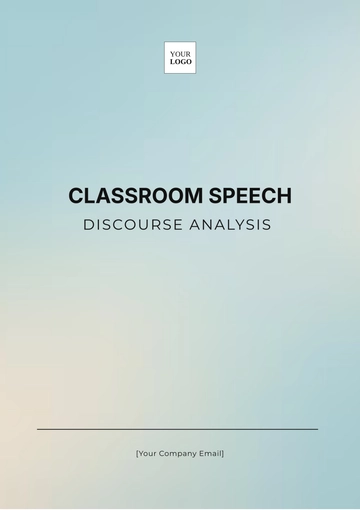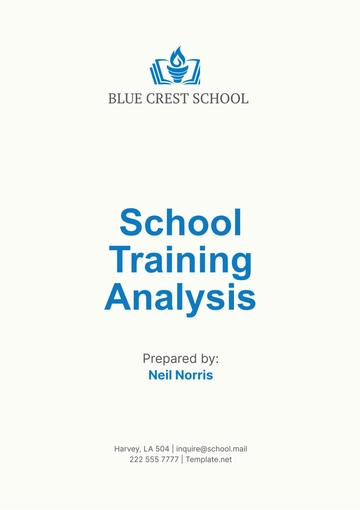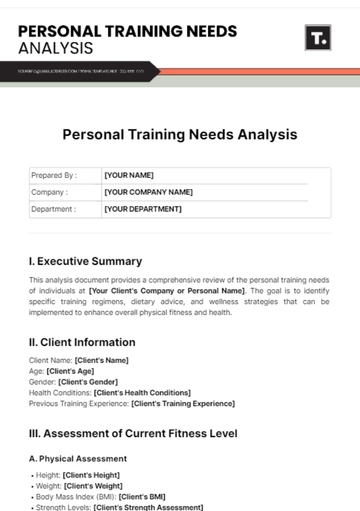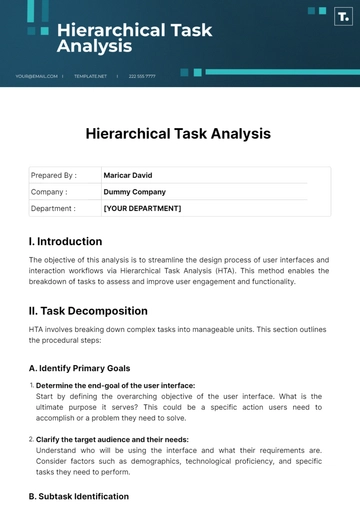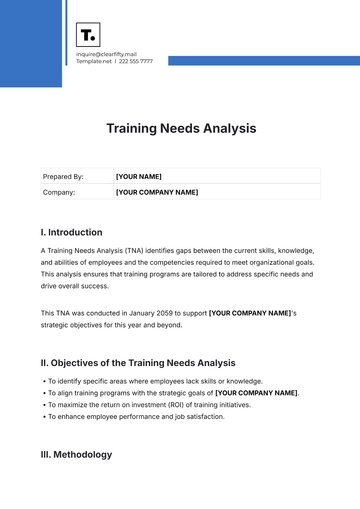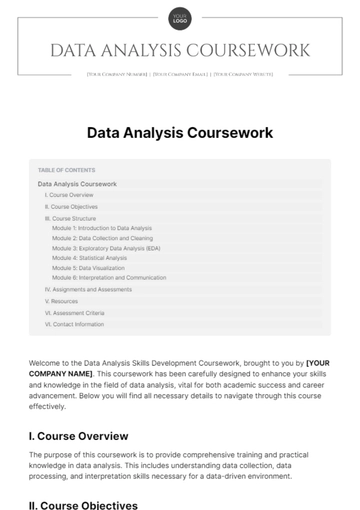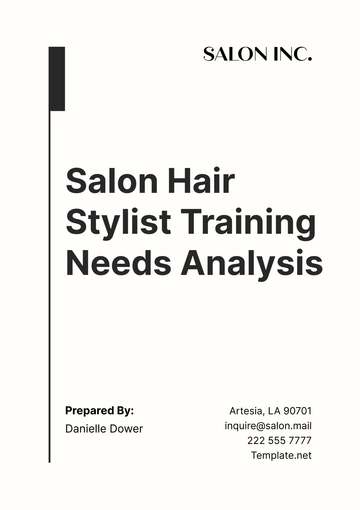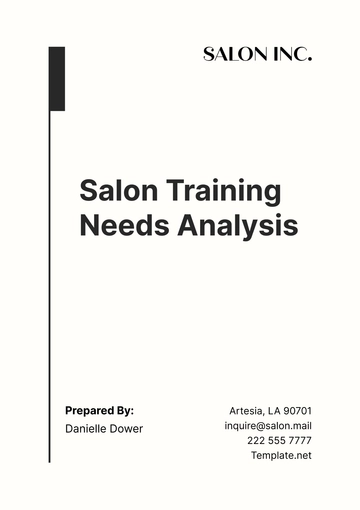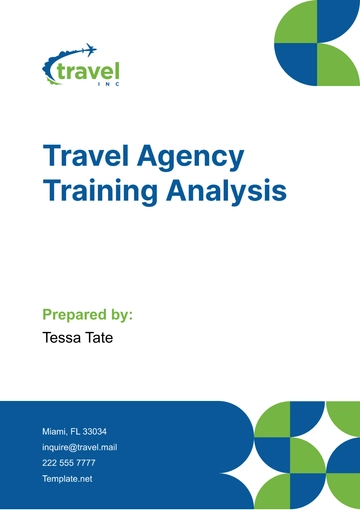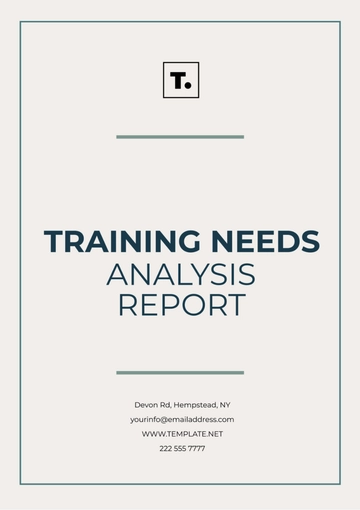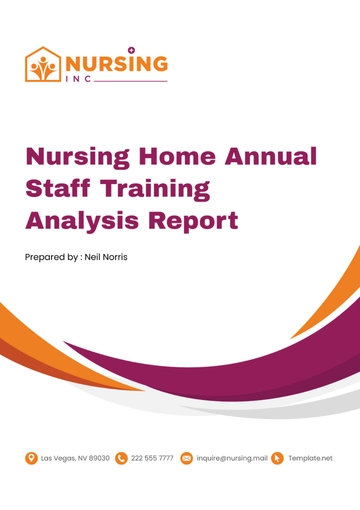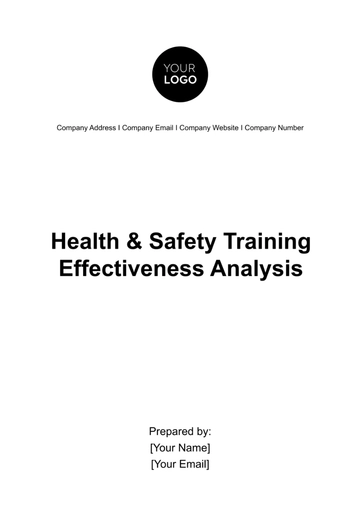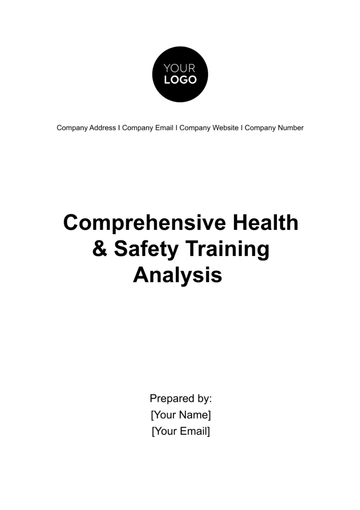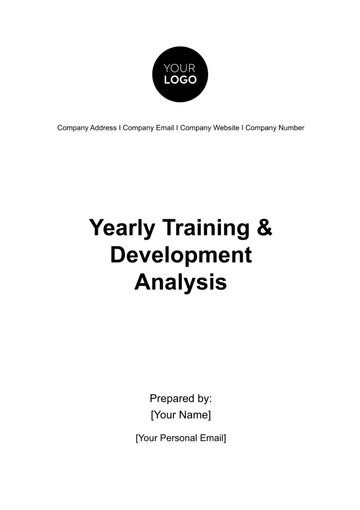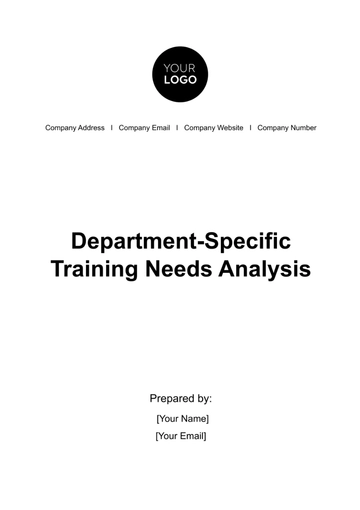Free Travel Agency Training Analysis
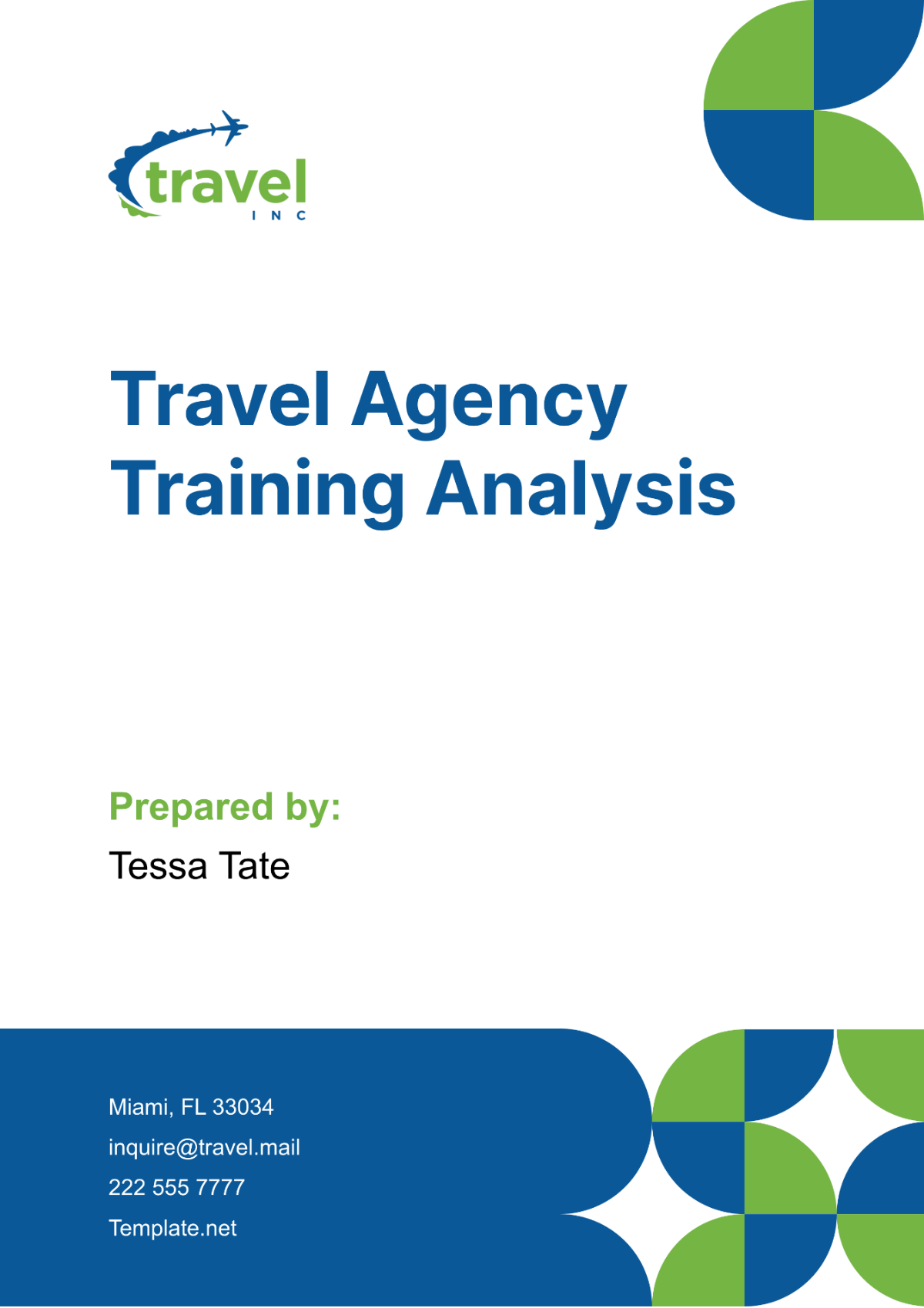
I. Introduction
A. Purpose of the Training
Enhancing Employee Skills: [Your Company Name]'s training programs are designed to enhance the skills of our employees, making them more competent in their roles. This includes both technical skills related to the travel industry and soft skills such as communication and customer service.
Improving Service Quality: By improving the skills of our employees, we aim to improve the quality of service provided to our clients. This is crucial as high-quality service is a key differentiator in the competitive travel industry.
Boosting Customer Satisfaction: With improved service quality, we aim to increase customer satisfaction, leading to higher customer retention rates. We believe that satisfied customers are more likely to return for future travel needs and recommend our agency to others.
B. Scope of the Analysis
New Hires: The analysis includes the impact of our training programs on new hires, assessing how effectively they have been able to integrate into our agency and perform their roles. We believe that effective training can shorten the learning curve for new hires and enable them to contribute to the agency more quickly.
Existing Employees: The analysis also covers the impact of our training programs on existing employees, evaluating how the training has helped them improve their skills and performance. We believe that continuous learning and development is key to maintaining a motivated and high-performing workforce.
Training Programs: The analysis covers all the training programs conducted over the past year, providing a comprehensive view of the effectiveness of our training initiatives. This includes both mandatory training programs and optional ones that our employees can choose to attend based on their interests and career goals.
C. Significance of the Analysis
Refining Training Initiatives: The analysis will help [Your Company Name] refine training initiatives, ensuring they are aligned with strategic goals and the expectations of customers. This includes both updating existing training programs and developing new ones based on identified needs.
Improving Employee Performance: By identifying the strengths and weaknesses of our training programs, we can take steps to improve employee performance. This includes providing additional support and resources to our employees and recognizing and rewarding high performance.
Enhancing Customer Satisfaction: We believe that improved employee performance will lead to better service quality, enhancing customer satisfaction and loyalty. This is crucial as satisfied customers are more likely to return for future travel needs and recommend our agency to others.
II. Methodology
At [Your Company Name], we have adopted a mixed-methods approach for conducting this analysis. This approach incorporates both quantitative data from customer feedback scores and qualitative assessments from staff surveys post-training. The training sessions observed were those conducted over the last 12 months, involving both new hires and existing employees.
A. Data Collection Methods
Customer Feedback: We have collected quantitative data directly from our clients who were served by our recently trained staff. This data provides us with measurable and comparable metrics to assess the impact of our training programs. It allows us to understand our clients’ perception of our service quality and identify areas where we excel and where we need to improve.
Staff Surveys: Post-training surveys were conducted among our staff to gather qualitative data. These surveys provide us with insights into the staff’s perception of the training programs and their effectiveness. They allow us to understand how our staff view the training programs, what they find useful, and what they think could be improved.
Trainer Evaluations: Our trainers have also provided evaluations of the trainees’ performance during the training sessions. These evaluations give us another perspective on the effectiveness of our training programs. They allow us to understand how well our trainees are absorbing the training material and applying it in their roles.
B. Observation Period
New Hires: The analysis includes the impact of our training programs on new hires, assessing how effectively they have been able to integrate into our agency and perform their roles. This is important as effective training can shorten the learning curve for new hires and enable them to contribute to the agency more quickly.
Existing Employees: The analysis also covers the impact of our training programs on existing employees, evaluating how the training has helped them improve their skills and performance. This is crucial as continuous learning and development is key to maintaining a motivated and high-performing workforce.
Training Programs: The analysis covers all the training programs conducted over the past year, providing a comprehensive view of the effectiveness of our training initiatives. This includes both mandatory training programs and optional ones that our employees can choose to attend based on their interests and career goals.
C. Data Analysis Methods
Statistical Analysis: Statistical analysis of the quantitative data from customer feedback scores allows us to identify measurable improvements in service quality post-training.
Thematic Analysis: Thematic analysis of the qualitative data from staff surveys helps us understand the staff’s perception of the training programs and identify areas for improvement.
D. Integration of Findings
Outcome Measures: The quantitative data provides us with direct outcome measures such as improvements in customer service scores post-training.
Personal Insights: The qualitative data provides us with personal insights from our staff about their experience with the training programs.
E. Limitations of the Methodology
Subjectivity in Qualitative Data: While qualitative data provides valuable insights, it is subjective and can vary greatly between individuals.
Variability in Quantitative Data: While quantitative data provides measurable and comparable metrics, it can be influenced by various factors beyond the training programs.
Limited Observation Period: While the 12-month observation period provides us with long-term data, it may not capture the full impact of our training programs, especially for those that are designed for long-term career development.
III. Key Findings
At [Your Company Name], we have conducted a comprehensive analysis to evaluate the effectiveness of our training programs. The findings from this analysis are crucial in understanding the impact of our training initiatives on our travel agency staff and the services they provide to our clients. The following chart and table below summarize the key findings:
Aspect | Pre-Training | Post-Training | Change |
|---|---|---|---|
Customer Service Scores | 72% | 90% | +18% |
Employee Satisfaction Index | 65% | 88% | +23% |
Application of Training | 80% | 100% | +20% |
Employee Confidence | 70% | 85% | +15% |
Customer Retention Rate | 75% | 92% | +17% |
A. Customer Service Scores
Our customer service scores saw a significant increase from 72% pre-training to 90% post-training, marking an 18% improvement. This indicates that our training programs have been successful in enhancing the service skills of our staff. Improved customer service is likely to lead to higher customer satisfaction, which is a key factor in customer retention and loyalty.
B. Employee Satisfaction Index
The Employee Satisfaction Index rose from 65% pre-training to 88% post-training, indicating a 23% increase. This suggests that our training programs have been effective in improving job satisfaction among our staff. Higher job satisfaction can lead to increased employee engagement and productivity, which can ultimately contribute to improved service quality.
C. Application of Training
The application of training saw a substantial increase from 80% pre-training to 100% post-training. This 20% increase demonstrates that all the employees were able to apply the skills and knowledge acquired from the training to their day-to-day tasks. This is a strong indicator of the practical relevance and effectiveness of our training programs.
D. Employee Confidence
There was a notable increase in employee confidence from 70% pre-training to 85% post-training, marking a 15% improvement. This suggests that our training programs have been successful in boosting the confidence of our staff in their roles. Increased confidence can lead to improved performance and higher job satisfaction.
E. Customer Retention Rate
Our customer retention rate saw a significant increase from 75% pre-training to 92% post-training, indicating a 17% improvement. This suggests that the improvements in service quality and employee satisfaction post-training have led to higher customer loyalty.
Our analysis underscored the overall importance of continuous training in a dynamic industry like travel. The travel industry is constantly evolving, with new trends, technologies, and customer expectations. Continuous training ensures that our staff stays updated with these changes and is equipped to provide the best service to our clients.
Moreover, it also highlighted the role of training in employee retention. By investing in our employees’ growth and development, we are showing them that we value their contribution and are committed to their career progression. This can lead to higher job satisfaction, increased loyalty, and lower turnover rates, all of which are beneficial for the long-term success of our agency.
Overall, this analysis has shown that our training programs have been effective in improving both our service quality and employee satisfaction. However, continuous improvement is a key part of our ethos at [Your Company Name]. We will take these findings into account as we strive to further enhance our training programs and continue to provide exceptional service to our clients.
IV. Actionable Recommendations
Based on the findings from our analysis, these are the identified several areas for improvement in our training programs:
A. Enhance the Training Curriculum
Incorporate Advanced Communication Skills: Our analysis revealed that our staff would benefit from advanced communication skills training. This could include modules on effective listening, empathy, and dealing with difficult customers.
Include Crisis Management Modules: Given the dynamic nature of the travel industry, it is crucial for our staff to be equipped to handle crises effectively. This could involve dealing with last-minute cancellations, natural disasters, or other unforeseen events.
Update Product Knowledge: Our training programs should also regularly update our staff’s knowledge about our travel packages and services. This will ensure that they are always equipped to provide accurate and up-to-date information to our clients.
B. Increase Training Frequency
Regular Refresher Courses: To ensure that our staff’s skills and knowledge remain current, we recommend scheduling bi-annual refresher courses. These courses could cover updates in the travel industry, new agency policies, and revisions in our service offerings.
Continuous Learning Opportunities: In addition to the scheduled training programs, we should also provide our staff with continuous learning opportunities. This could include access to online courses, industry seminars, and workshops.
Performance-Based Training: We could also consider implementing performance-based training, where staff members who excel in certain areas are given the opportunity to undergo advanced training. This could serve as a motivation for our staff to continuously improve their performance.
C. Implement a Mentorship Program
Pair New Hires with Experienced Staff: A mentorship program where new hires are paired with experienced staff members could be beneficial. The mentors can provide guidance and support to the new hires, helping them to integrate into the agency more quickly.
Foster Continuous Learning: The mentorship program could also foster a culture of continuous learning within our agency. The mentors can share their experiences and insights with the new hires, while also learning from the fresh perspectives that the new hires bring.
Enhance Knowledge Sharing: The mentorship program could also enhance knowledge sharing within our agency. This could lead to more innovative solutions to challenges and improved service quality.
D. Improve Feedback Mechanisms
Develop Robust Feedback Collection Methods: To better understand our clients’ needs and expectations, we need to develop more robust methods for collecting customer feedback. This could include regular customer surveys, feedback forms, and social media monitoring.
Analyze Customer Feedback: We should also regularly analyze the customer feedback to identify trends and patterns. This will provide us with valuable insights into areas where we are doing well and where we need to improve.
Implement Changes Based on Feedback: Most importantly, we need to be responsive to the feedback and implement changes accordingly. This will show our clients that we value their feedback and are committed to improving our services.
E. Foster a Culture of Continuous Improvement
Encourage Staff Feedback: We should encourage our staff to provide feedback on the training programs. Their insights and suggestions could be invaluable in improving the effectiveness of the training.
Regularly Review Training Programs: We should regularly review our training programs to ensure that they remain relevant and effective. This could involve assessing the impact of the training on staff performance and customer satisfaction.
Stay Abreast of Training Best Practices: We should also stay abreast of the latest training best practices in the travel industry. This will allow us to continuously improve our training programs and ensure that our staff is always equipped with the latest skills and knowledge.
V. Conclusion
At [Your Company Name], we believe in the power of continuous learning and improvement. Our analysis of the training programs has provided us with valuable insights into their effectiveness and areas for improvement. Based on these findings, we have identified several actionable recommendations that can further enhance the impact of our training initiatives.
First, we recognize the need to enhance our training curriculum. This includes incorporating advanced communication skills and crisis management modules, which our staff has identified as crucial for their roles. We also see the importance of increasing the frequency of our training programs. Regular refresher courses and continuous learning opportunities can ensure that our staff stays updated with the latest trends and technologies in the travel industry. Furthermore, we propose the implementation of a mentorship program. Pairing new hires with experienced staff can foster a culture of knowledge sharing and continuous learning within our agency.
Second, we understand the importance of feedback in improving our services. Therefore, we aim to improve our feedback mechanisms by developing robust methods for collecting and analyzing customer feedback. This will allow us to better understand our clients’ needs and expectations, and make necessary improvements in our service quality. In addition, we plan to encourage our staff to provide feedback on the training programs. Their insights and suggestions could be invaluable in enhancing the effectiveness of our training initiatives.
Overall, by implementing these recommendations, we at [Your Company Name] aim to further enhance our service quality, boost employee satisfaction, and ultimately, increase customer satisfaction and loyalty. We are committed to providing exceptional service to our clients and believe that our dedicated and well-trained staff is key to achieving this goal.
- 100% Customizable, free editor
- Access 1 Million+ Templates, photo’s & graphics
- Download or share as a template
- Click and replace photos, graphics, text, backgrounds
- Resize, crop, AI write & more
- Access advanced editor
Evaluate and improve staff training programs with our editable and customizable Travel Agency Training Analysis Template! This analytical tool from Template.net helps your agency assess the effectiveness of training initiatives in enhancing employee skills, knowledge, and performance! Utilize our AI Editor Tool to customize the template to your needs today!
